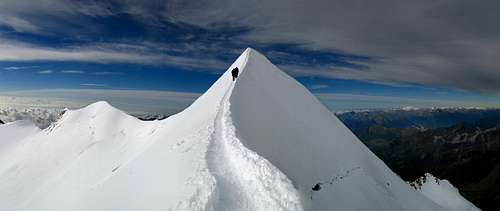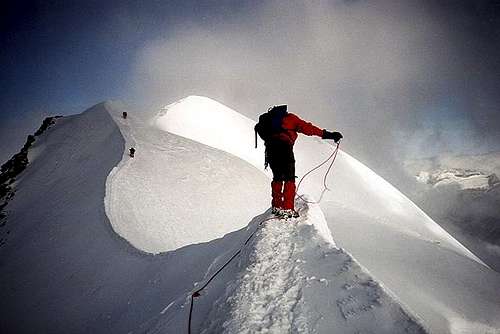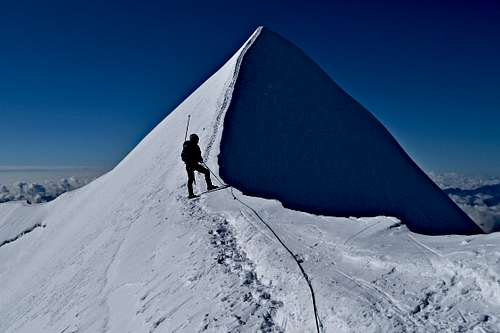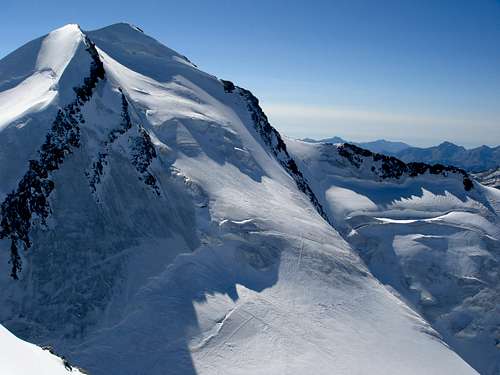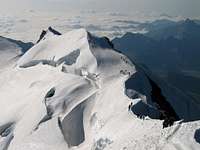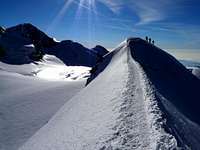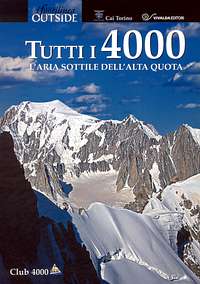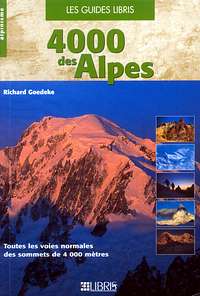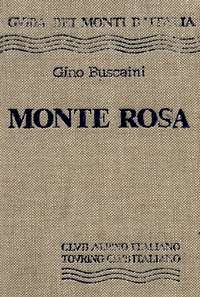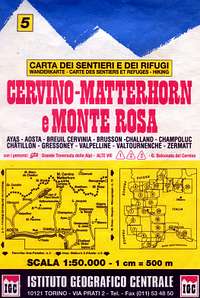-
 97692 Hits
97692 Hits
-
 98.34% Score
98.34% Score
-
 81 Votes
81 Votes
|
|
Mountain/Rock |
|---|---|
|
|
45.92138°N / 7.79259°E |
|
|
Valle d'Aosta |
|
|
Mountaineering, Trad Climbing, Ice Climbing, Mixed |
|
|
Spring, Summer |
|
|
13864 ft / 4226 m |
|
|
Overview
Castore 4226 m
Castore 4226 m - Castor for the Swiss - is one of the best classic mountains of the Monte Rosa massif in the Pennine Alps. It is located on the border between Valle d'Aosta (Italy) and Valais (Switzerland), along the main alpine watershed running from Breithorn to Punta Dufour. More in detail, it is located between the Polluce, from which it is separated by the Passo di Verra 3845 m, and the Western Lyskamm, from which it is separated by the Felikjoch 4061 m. Together with its neighbour Polluce - or Pollux - it forms the "Gemelli" or "Zwillinge" ( "the twins"), as the locals call them. This particular shape appears especially when "the twins" are observed from the Swiss side. Their names derive from the Greek mythology. Higher than Polluce, Castore is one of the 4000s most visited in the Alps and one of the favorite destinations for climbers: in good weather it is not difficult to count dozens of people on the top. Check here the complete list of the 82 alpine Fourthousanders and the 46 minor summits: Club4000.

Particularly inviting because very aesthetic and not too difficult is the access from the Refuge Quintino Sella, where it starts the Normal Route on the South-East ridge. Castore does not present a climb with great technical difficulties along this route: the small ridges to overcome to reach the summit are very funny, though quite airy.
To this aesthetic snowy South-East ridge starting from the Felikjoch is opposed a steep ice slope facing North-West where it runs another frequently climbed route with access from the Colle del Breithorn. The Colle del Breithorn can be quickly approached both from the Testa Grigia, point of arrival of the Breuil-Cervinia cable car (Italy), and from the point of arrival of the Klein Matterhorn cable car. Castore can be climbed directly by traversing to South-East across the Verra glacier for about 1,30 to 2 hours to get the base of the mountain, then about a 45 minute push to the top.
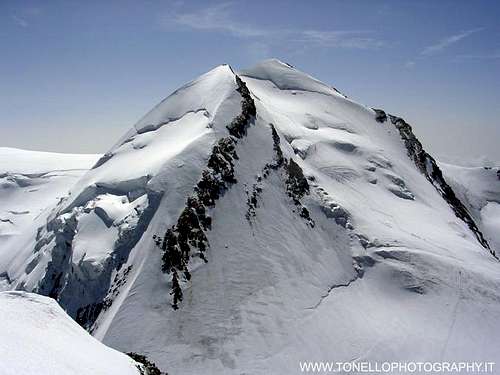
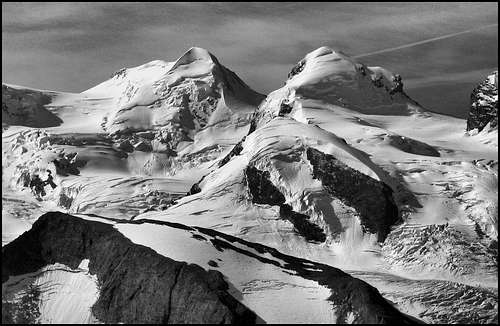
The NW route can be approached also from the Val d'Ayas across the Vallone di Verra with the huts Mezzalama and Guide della Val d'Ayas.

Another classic route starts from the Monte Rosa Hütte up and over the Zwillingsgletscher to the border ridge and to the summit. This is a long hump over 6-8 hours one way. Because of crevasses it is not recommend as a solo route.
Getting There
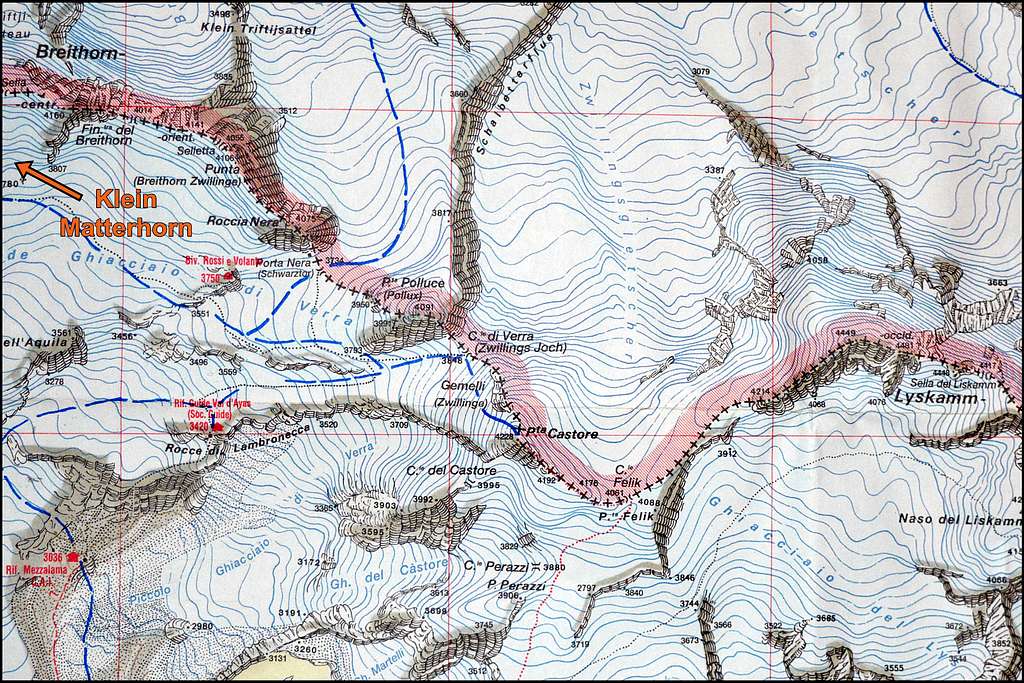
Italian side
Starting from the Italian side the routes to summit Castore are mainly two, the SE ridge and the NW slope. The SE ridge is the easiest route, so it's considered the true Normal route and starts from the Rifugio Quintino Sella 3585 m. The approach to the refuge is from Stafal 1825, in the upper Valle Gressoney.
The NW slope has two different approachs:
- via the Rifugio Guide del Cervino, Testa Grigia (approach from Breuil-Cervinia, Valtournanche)
- via the Rifugio Guide d'Ayas (approach from Champoluc, Val d'Ayas
So there are three different Aosta valleys with three different road approaches, depending from the itinerary you have chosen
Getting to Stafal (Valle di Gressoney)
The village of Stafal m. 1825, located in the high part of Valle di Gressoney, Aosta Valley can be reached from the A5 Motorway, exiting Pont St Martin, then following the Valle di Gressoney until the end of the road.
From Stafal m. 1825 to the Rifugio Quintino Sella m 3585
From the parking area a cable car leads 300 meters further up, where a chair lift by a long run leads up to Passo di Bettaforca m 2720. Here take the obvious path n. 9 to the Quintino Sella shelter, rising on the crest and getting quickly to the Bettolina Pass m. 2905. From here carry on the wide crest to the junction with the path coming from Pian di Verra. Follow the yellow marks, climb up some easy rocks, then follow the final airy ridge, equipped with fixed ropes, leading to the terrace on which is located the Rifugio Quintino Sella m. 3585.
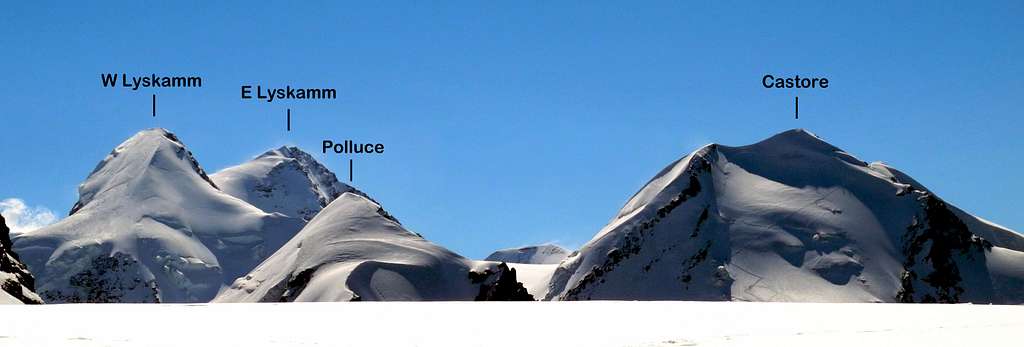
The quick approach to the NW slope starts from Rifugio Guide del Cervino m. 3480, located near the upper station of Testa Grigia cable-car, starting from Breuil-Cervinia, while the longest approach is from Rifugio Guide d'Ayas.
Getting to Breuil-Cervinia
Breuil - Cervinia is a major mountain resort, located at the end of the Valtournanche, Aosta Valley. Can be reached from the A5 Motorway, exiting Châtillon/Saint-Vincent, then following the Valtournanche. Public transportation is easy to arrange.
Getting to Champoluc
Another route starts from Rifugio Guide d'Ayas across Rifugio Mezzalama. The route to reach this huts starts from St. Jacques, a hamlet of Champoluc in Valle d'Ayas, Aosta Valley.The village of Champoluc can be reached from the A5 Motorway, exiting Pont St Martin, then following the Valle di Gressoney until the end of the road.

Swiss side
From the Klein Matterhorn Cable Car station.
Starting from Zermatt, on the Swiss side, the Castore can be climbed across the NW flank via the Klein Matterhorn Cable Car station. It can be reached by taking the cable car all the way from Zermatt or one can hike up to it from the Gandegg hut in about a 1/2 to 1 hour walk. One could also stay at the Hotel Schwarzsee which is furter away than Gandegg at about 1-1/2 hours hike.
From the Monte Rosa Hut
The longest way to summit Castore is from the Monte Rosa Hut. Approaches:
- from the station Rotenboden (Gornergrat cable car) over the Gornerglacier in 2 - 2,5 h, 200 m up and down. The route on the glacier is partially marked by poles. From the station Rotenboden, you choose the way with S-direction to the ridge saddle in the E of the Riffelhorn (signs). After about 100 meters, the route goes up over the Gornerglacier to the E and slightly down to the S-flank of the Gorner-ridge. You reach the Grenzglaicer and traverse it to the S till you reach the E-side of the Grenzglacier. You climb up on the glacier below the hut. You reach the hut via the moraine with short zigzag (100hm).
- from the station Stockhorn. You pass the Stockhorn in 30 min. to the E to the Stockhornpass and traverse the Gornerglacier at the foot of the Punta Nordend (NW). Then you go at the left side down and along the Monte-Rosa-Glacierbreak and the rocks. You reach the edge on about 3120 m (pole). You go up slightly on the S-side and traverse the middle tongue of the Monte-Rosa-glacier to the Unteren Plattje and the hut (2-3h)
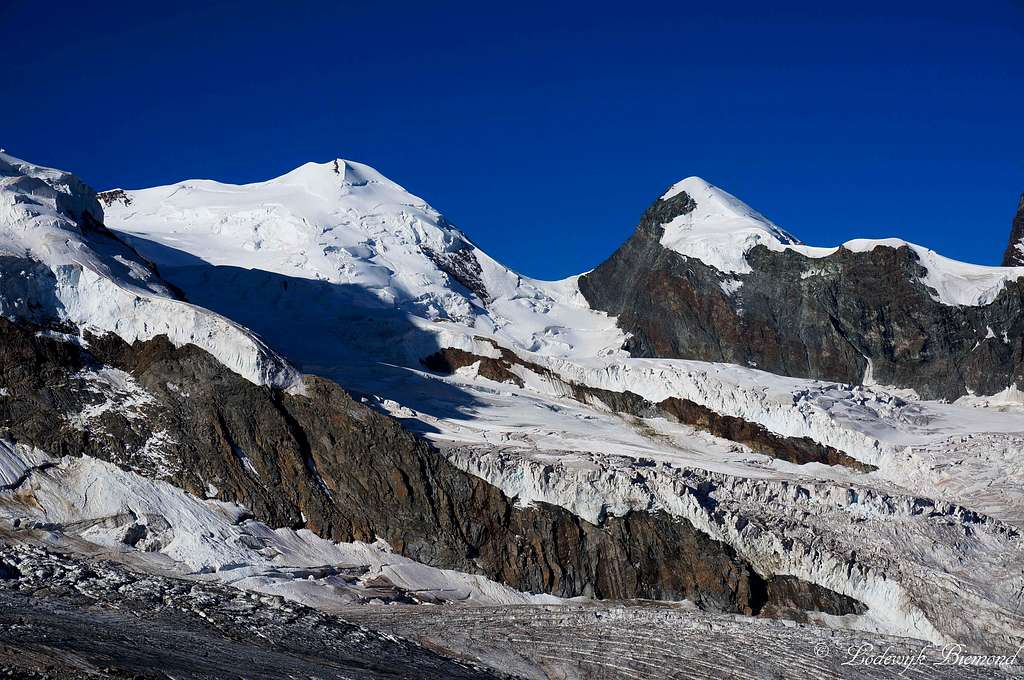
SE ridge Normal route
- Castore SE Ridge Normal route Click this link on SP providing the full report of this route
Difficulty: Alpine F+
Difference in level: 640 m. from Rifugio Quintino Sella
Exposure: SE
First ascent: William Mathews and F.W. Jacomb with the guides J.B. Croz and Michel Croz 23- august 1861
A fine route - entirely glacial - without particular technical difficulty, but the ridge is airy and sharp and it should not be underestimated
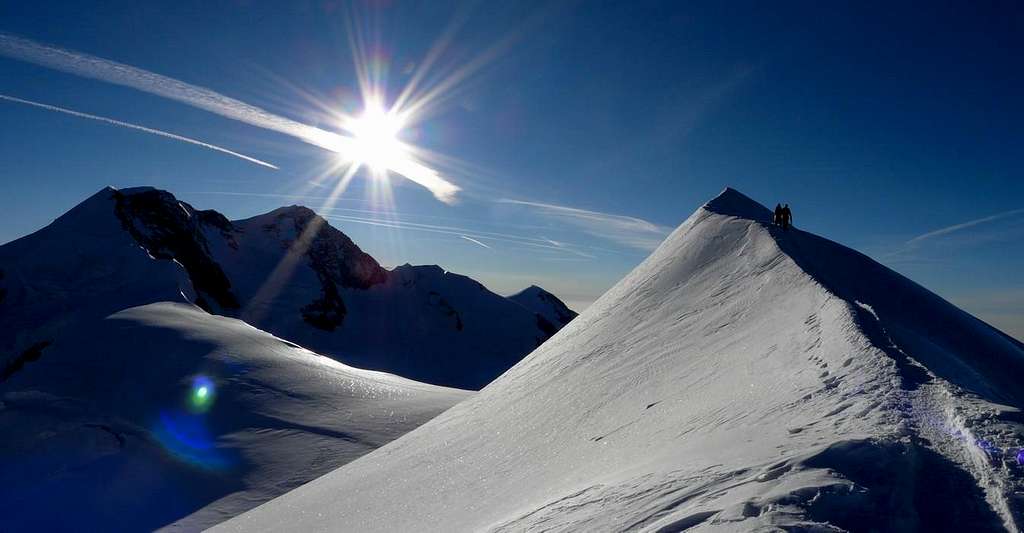
Castore WNW Flank
- Castore WNW Flank Click this link on SP providing the full report of this route
Difficulty: Alpine PD+
Exposure: WNW
It's the second route usually climbed to reach the summit, a little more demanding than the previous route. The final ascent is made from the Zwillingsjoch, a 3848 m high pass on the Western side of Castore. As previously told the Zwillingsjoch may be approached from four different starting points:
- from the Rifugio Guide del Cervino on Testa Grigia cable-car upper station (Italy, Cervinia)
- from the Klein Matterhorn station 3883 m on the Swiss side of the border with Italy (Switzerland, Zermatt)
- from the Rifugio Guide d'Ayas (Italy) - from the Monterosa Hut (Switzerland) - it's the longest approach
Other routes
- South wall and SW ridge - AD
- NW wall of SW spur - TD/ED
Huts
Italian side
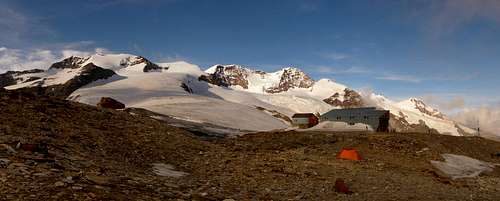
Rifugio Quintino Sella m. 3585 - Phone +39 0125 366113 Mob +39 348 8107793 E-mail: info@rifugioquintinosella.com
Situation: Felik Glacier shore
Open: from middle June to middle September
Size: 140 persons + 25 in the winter shelter
Owner: CAI Sez. Biella
Guardian: Ezio Cassina
Getting there: From Gressoney-la-Trinité reach Stafal hamlet 1825 m (5 km from the capital). Wide parking lot. From the parking area a cable car leads 300 meters further up, where a chair lift by a long run leads up to Passo di Bettaforca m 2720. Here take the obvious path n. 9 to the Quintino Sella shelter, rising on the crest and getting quickly to the Bettolina Pass m. 2905. From here carry on the wide crest to the junction with the path coming from Pian di Verra. Follow the yellow marks, climb up some easy rocks, then follow the final airy ridge, equipped with fixed ropes, leading to the terrace on which is located the Rifugio Quintino Sella m. 3585.
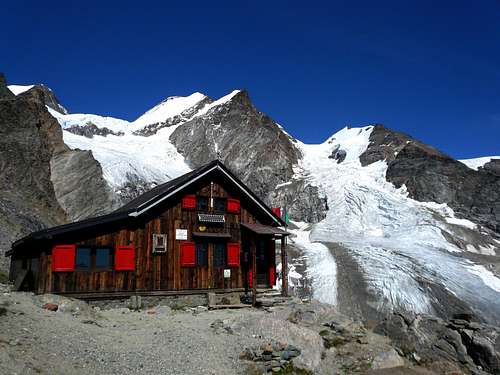
Rifugio Mezzalama 3004 m - Phone: 0039-0125-307226 - e mail info@rifugiomezzalama.it
Situation: Ghiacciaio di Verra
Open: summer
Size: 36 persons + 20 persons in the winter shelter: 20 persons
Owner: C.A.I. Torino
Guardian:Maurizio Piffari (mobile 328 2128835)
Getting there - From Champoluc, hamlet St. Jacques. We leave the car in the church square and continue on foot for a few minutes to the Blanchard district. Here the signpost indicate the direction of the path n ° 7. After a small bridge, the trail leads through the woods, passes a clearing and into the wood again until converging with the dirt road (closed to vehicles) coming from Saint-Jacques. Cross the Pian di Verra Inferiore, after which the signposts indicate the Blue Lake and on the right Rifugio Mezzalama and Rifugio Guide Val d'Ayas. After crossing the bridge, we follow the path which cuts the road then along the river we enter a valley that leads to the Upper Pian di Verra. Shortly before, indicated by two signs, the trail branches off to the left and up the steep slope that forms the other side of the moraine. The trail passes along the edge of the moraine in sight of the hut, then it appears also the higher Rifugio Guide Val d'Ayas. Yet following the moraine we reach the hut.

Rifugio Guide d'Ayas - Phone: 0039-0125308083 Email: info@rifugio-lambronecca.com
Situation: Lambronecca spur
Open: from July to September
Size: 85 persons + 16 persons in the winter shelter
Guardian: Guide di Champoluc e Val d'Ayas
Getting there - Same approach as for Rifugio Mezzalama, then continue towards a side-tongue of the Grande Ghiacciaio di Verra. Cross the glacier and take the path on stony ground again. With the help of some footbridges and fixed ropes, the path overcomes the rocky promontory on which the refuge is located 4.30-5.30. Alternatively from Saint Jacques you can get on with an authorized taxi at Piani di Verra and for the previous access to the shelter
Swiss side
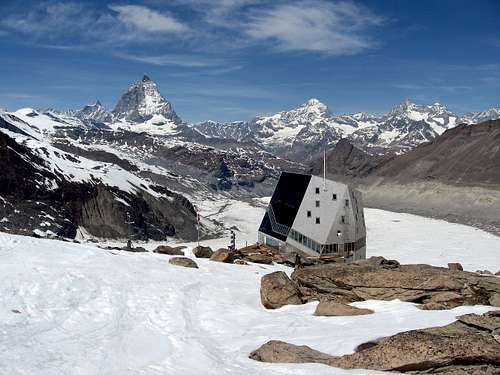
Monte Rosa Hütte 2883 m - Phone: +41-279672115 Email: huettemonterosa@gmail.com
Situation: Grenzgletscher
Open: from mid-March to mid-May and from mid-June to mid-September
Size: 120 persons + 28 persons in the winter shelter
Owner: Swiss Alpine Club

Getting there - Summer: from Zermatt take the Gornergrat train to Rotemboden 2815 m. From here take the path to the Gornergletscher, marked with poles, small flags, white and blue stamps, fixed ropes in some stretches. You cross the glacier and pass on the Grenzgletscher, then you head to the Untere Plattje morain and climb it to get the refuge. 2,30-3 h. Winter: as Monte Rosa Hütte can also be reached from Stockhorn, where you arrive by the train to Gornergrat and then by the cableway to Hohalligrat and then by the same Stockhorn. And you can also cross the ridge to the Gornergrat. Once at the Stockhorn pass, continue towards Plattje Unteren, reaching the refuge in about three hours. An additional possibility is to start from the Furi locality through the Gorner glacier: an itinerary of about 9 kilometers not marked and must be built by trained people, preferably on a rope. The difference in height is 940 meters, the time is 4 hours.
History
The particular names Castor and Pollux, or Gemini, come from the Greek mythology and refersto the two twin deities called "Diòscuri", sons of Zeus. They were worshiped in the ancient Greece as protectors of sailors. The reason of the name derives from the particular form of twin peaks that Castore has together with the Pollux. The first ascent of Castore was performed in 1861, August 23 by the two British alpinists F.W. Jacomb and W. Mathews with J.B. and M. Croz. Castore has become famous also in reason of the transit of the "Ottorino Mezzalama" ski-mountaineering contest, a big course with ski that starts from Teodulo (Cervinia) and ends in Gressoney, after having passed the Lyskamm Nose.
When To Climb
Mountaineering. from June to September (crowded in July and August)
Ski-mountaineering: Good at all times except when there are heavy snow conditions can cause local avalanches.
Meteo forecast
- Meteo Valle d'Aosta
- Meteo Switzerland
Guidebooks and maps
Guidebooks
"Il grande libro dei 4000 - Vie normali e classiche" by Marco Romelli, Valentino Cividini - Idea Montagna Editore, 2015
“Tutti i 4000 – L’aria sottile dell’alta quota” – Club 4000, CAI Torino – Vivalda Editori
“4000 delle Alpi” by Richard Goedeke - Ed. Libris
“Monte Rosa” by Gino Buscaini - Guida dei Monti d'Italia C.A.I.-T.C.I.
"Guide des Alpes Valaisannes" Vol. 4 (in French or German)
Italian Maps
"Breuil/Cervinia-Zermatt" Kompass map 1:50.000.
"Cervino-Matterhorn e Monte Rosa" n. 5 - Istituto Geografico Centrale map 1:50.000
"Monte Rosa, Alagna e Macugnaga" n. 10 Istituto Geografico Centrale, Torino 1:50000
Swiss Maps
"Matterhorn-Mischabel" n. 5006 1:50000 (only valuable if access from north)
"Gressoney" n. 294 1:50000 (shows all the Italian part)
Literature
"The High Mountains of the Alps" - Dumler/Willi P. Burkhardt, 1994. (to order at amazon.com) ISBN 0898863783
"Viertausender der Alpen" 11th ed. Munich 1998 Dumler/Willi P. Burkhardt, ISBN 3-7633-7427-2
"Walliser Alpen" DAV-Gebietsführer. 12th ed. Munich 1999 Michael Waeber, . ISBN 3-7633-2416-X
"Walliser Alpen - Die 100 schönsten Touren" 2nd ed. Munich 1990, Michel Vaucher ISBN 3-7654-2124-3
External Links
- Zermatt - Alagna - Castor at www.4000er.de - images, routes, coordinates and more information about the highest peaks of the Alps


